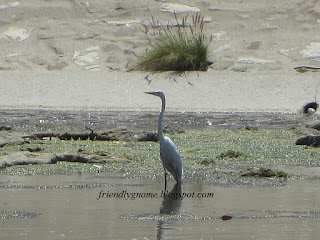It is one of the smallest marine mammals and one of the cleverest as well for it is quite adept at using rocks to crack open its favorite meal, the sea urchin.
Unlike other marine mammals which have blubber for protection, this animal relies on its very dense fur for warmth and repelling water.
It is also undoubtedly one of the cutest animals Mama gnome had ever seen up close.
If you guessed sea otter as the Mystery Animal, Mama gnome gives you a big hug and invites you to join her in the annual International Coastal Cleanup Day on September 21, 2013.
photo by : Mike Baird
An adult sea otter can grow up to 1.2 to 1.5 m (3 ft 10 in to 4 ft 10 in) in length and weigh from 22 to 45 kg (49 to 99 lb).
Its fur is usually brown but can also range from yellowish brown to almost black.
The sea otter sheds its fur gradually all year allowing the animal to maintain its thick fur which is vital for survival in the cold ocean waters.
The sea otter has a thick, somewhat flat tail which helps propel it in the water.
The otter can swim up to 5.6 mph or 9 km per hour. When it swims underwater it keeps its body long and streamlined and while above water it usually floats on its back quite easily, thanks to the the trapped air in its thick fur, making it very buoyant.
Besides its power of buoyancy and cuteness, sea otters are vital for maintaining kelp forest ecosystems.
Without sea otters, sea urchins population will grow rampant and what is bad about this?
Sea urchins eat the root systems of kelp forests so if the otters are not there to keep them in check, sea urchins will thrive and eventually kill the kelp forests leading to urchin barrens.
Here is a video of sea otters working hard to save our kelp forests.
video by: BBC
Sea otters' population is decreasing. They are threatened by oil spills, predators, disease, and conflict with fisheries.
Mama gnome would like to float in the ocean, buoyed up by her gnomish folds, bang on a rock just for the heck of it, and say, please help our sea otters continue to thrive and live in our kelp forests.
Please help in your own human way every day and stay green.
(c) friendlygnome.blogspot.com



.JPG)










.JPG)



.JPG)







